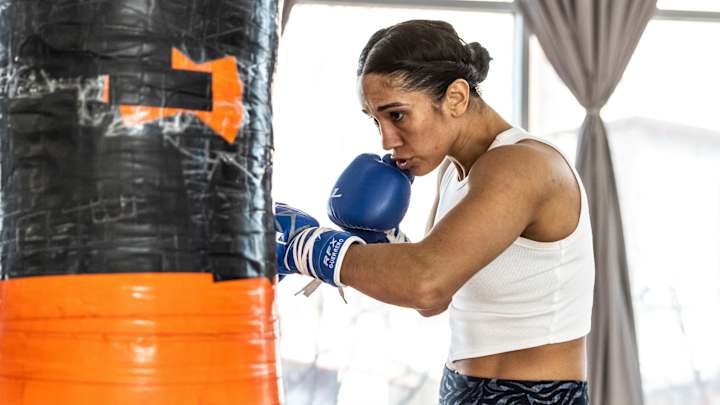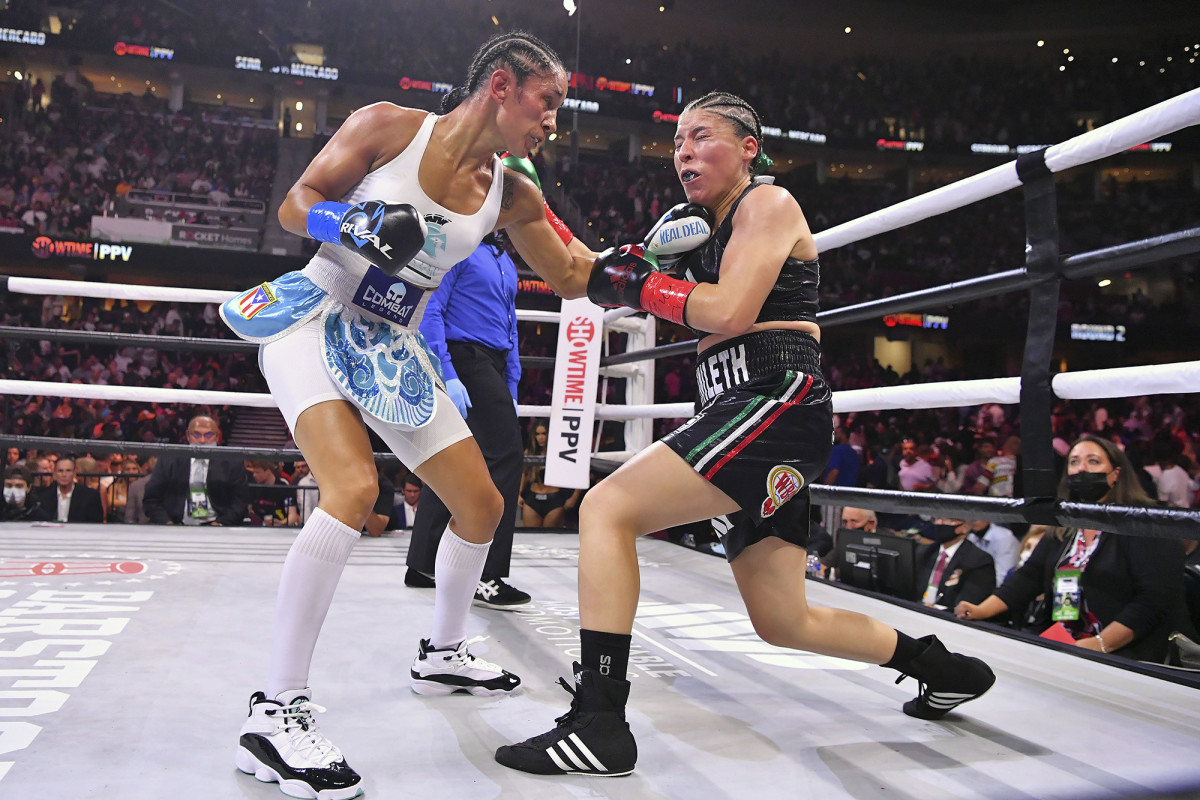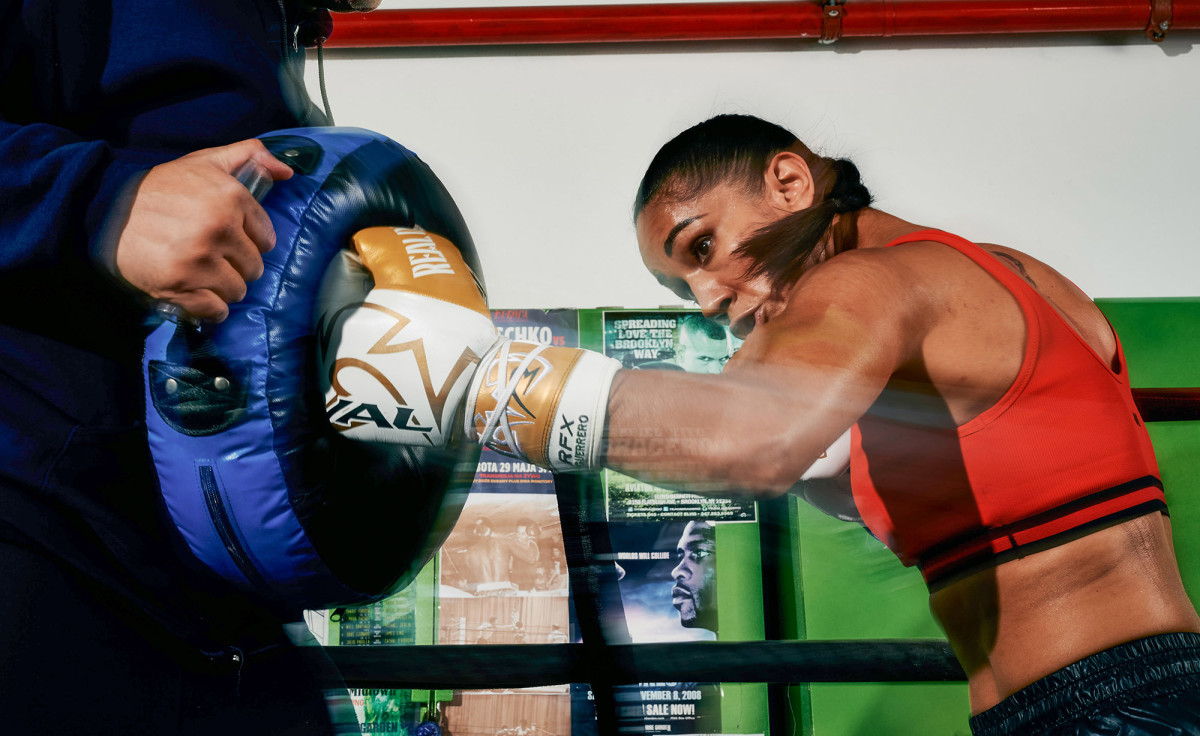The Introvert and the YouTube Sensation

Amanda Serrano is 33 years old and has never owned a cellphone. She has never been on a date. She claims “no friends” beyond her close-knit family. She does have social media accounts but doesn’t run them, save for the occasional check-in on a borrowed device. And, inside this mundane world she has created, she names but two vices: watching movies and shopping. Even then, her preferred store is Amazon’s website.
“I’m probably going to beat the 40-year-old virgin,” she says with a laugh over a Zoom call.
Serrano is a walking, punching, abstaining contradiction. A series of them, in fact. The human—daughter, sister, Prime delivery devotee—describes herself as “boring.” The professional boxer—42-1-1, 30 knockouts, champion in seven weight divisions—is a thunderous in-ring stalker who so acutely disfigured her last opponent’s face she “felt bad” for how she won.

How the person became the champion is the story of those contradictions. They help explain Serrano, her endless sacrifice and her 15-year pursuit of ambitions she could never completely define until recently. Years of earning three-figure paydays in rinky-dink gyms, followed by years of collecting belts in anonymity, followed by, well, something like fate. And in the form of a social media influencer, no less.
Many traditionalists view that influencer, 25-year-old Jake Paul, as the worst part of a sport with no shortage of issues. But to Serrano, he’s the person—a “kid,” she calls him—who shone a spotlight over her low-slung career trajectory until it pointed at the most significant fight in the history of women’s boxing.
Thus the contradictions continue, heightened by the twist. The boxer who never owned a cellphone signed with the boxer-promoter whose fame resulted from the ubiquity of the devices tucked into so many pockets. The kid from New York who knew Madison Square Garden as little more than a building will soon partake in the venue’s first women’s boxing main event, where she’ll try to take four belts from Katie Taylor. The toiler is doing the same things—taking fights and winning them—only now, strangers, teenagers especially, recognize her on the street. “I can’t believe people are excited to see me,” Serrano says. “I’m always like, ‘Why? I’m a normal person.’” Albeit one with nine world titles in weight classes that range from 115 to 140 pounds and a place in Guinness World Records for number of divisions vanquished (seven) by a female fighter.
Another contradiction: The boxer who stands on the precipice of history never planned to box. Serrano remembers watching only one pro bout in her entire childhood: Oscar De La Hoya vs. Félix Trinidad, a blockbuster featuring two undefeated champions held in September 1999. Because their family is Puerto Rican, and because Trinidad was their champion, the Serranos held a party at the house they still share in Brooklyn. Young Amanda missed Trinidad’s triumph; after a few rounds, she had gone outside to play. But as she watched the post-fight revelry, pure joy spreading across the faces of her relatives, she noticed something else: the significance.
The power of that night didn’t hit Amanda until later, long after her sister, Cindy, met Jordan Maldonado, a boxing trainer. Amanda was 12 when Cindy started heading to Maldonado’s gym for workouts. Sometimes, Amanda tagged along, wanting to be near her “idol,” her older sister by six years. As weeks turned into months, Amanda watched, passively. But on one random Saturday afternoon in 2001, she jumped into an informal sparring session on a whim. She did well and returned the next weekend and the weekend after that. Only on that day, her third as a “boxer,” Maldonado placed Amanda opposite a boy who knew how to punch. “He kept fighting back,” she says, recalling the tears that fell from her bruised face.
From that third session until age 18, she worked at the gym but never boxed. Until one day, while reading a newspaper, she spied an ad for the most prestigious local amateur tournament, the New York Golden Gloves. On another whim, she entered.
When she told Maldonado of her plan, he stifled a laugh. These were real boxers who could inflict serious damage. But Amanda persisted, until Maldonado turned to her and said, simply, “Suit up.” This time, the sisters sparred with each other, so that, Amanda says, “she could beat [the notion] out of me.” Amanda cried after that session, too, only to come back the next day. More crying followed, as did more sparring. Eventually, Amanda wore down her trainer and future brother-in-law, who decided to test her against a much larger opponent with 15 amateur fights. When Amanda held her own, everything changed.
Serrano’s no-friends, no-phones approach worked until “Operation Dumbbell” threatened to unravel the family’s plans. The nickname stemmed from an 18-month undercover investigation by the NYPD into two Brooklyn gyms—one operated and the other frequented by Maldonado. Detectives called the spaces “drug supermarkets” that peddled steroids, cocaine, ecstasy and OxyContin.
Maldonado and both Serrano sisters were among the two dozen people arrested and charged with criminal sale of a controlled substance in September 2007. Maldonado pleaded guilty in exchange for a reduced sentence and served a year in jail. Cindy faced nine years but avoided prison. Amanda’s case never went to court.
The family tries to avoid discussing the investigation.But any hope that they could simply put Operation Dumbbell behind them has proved false. Even in the lead-up to headlining at the Garden, Taylor’s team insisted on rigorous drug testing before agreeing to terms.
Amanda describes Maldonado, 56, who still trains her, by what he has done for her career. She made as little as $500 for one “prize” fight early on. Cindy had bouts where she made $50. Amanda says Maldonado—who declined to be interviewed for this story—sometimes paid their opponents out of his own pocket, or covered their travel expenses; anything to land another fight. “We’re going through the ups and downs together,” she says, vaguely.
Her focus has remained the same since 2009: her career. Serrano won the vacant IBF super featherweight title in ’11. Still, she didn’t know whether she could box and earn a living wage. So she also tried jujitsu and mixed martial arts and even briefly dabbled in pro wrestling. But she never stopped boxing, and the belt barrage began in earnest. She went up in weight. She went down in weight. She kept fighting. Kept winning. In ’19 she nabbed her seventh title, this one at 115 pounds.

In the history of boxing, only Manny Pacquiao could compare résumés in terms of weight classes conquered. And while it’s not an exact comparison, it’s still significant. Both Serrano and Pacquiao embraced a come-forward, action-packed, fists-of-fury style. Both are southpaws with high knockout rates. And both took on all manner of opposition—large and small, young and old, brawlers and technicians—a rarity in the modern fight game.
Boxing aficionados long ago took notice of Serrano. Some, like the actress Rosie Perez, even happened to be famous. Perez first stumbled upon the boxer’s brilliance a decade ago, when Serrano fought at Roseland Ballroom in New York City. Perez loves boxing and follows it obsessively, and she told her fight friends they needed to check Serrano out. “I was blown away,” she says.
Serrano didn’t utilize as much space in the ring or as many angles as Pacquiao, but both struck Perez as fighters, at their respective cores. As the years flew by and Serrano accumulated belts, Perez also wondered: Why hadn’t the fighter who impressed her all those years ago been given more respect, more resources, more of everything Serrano had clearly earned?
By early 2021, Serrano had to consider the same thing Pacquiao debated for the better part of the last decade before retiring—in theory—last year. What more could she accomplish? Along with Taylor and the supremely talented (and also undefeated) Claressa Shields, Serrano had ushered in another women’s boxing resurgence. She had won 26 straight bouts. What was left?
That’s where the influencer comes in.
As Jake Paul transformed from a lucrative sideshow into an improving, if oversold, professional boxer, those who questioned his bona fides often missed the salient points he made. Paul doesn’t care much about those critics. He compares the sport of boxing to taxi services, which “seemed pretty dope” until ride-shares like Uber came along. He believes he’s “the most influential person in boxing” because of his perspective, and he suggests that the word perspective be highlighted in this article. “The whole sport needs change,” he says. “Boxing has no organization. When I die, I want to [have added] some f---ing organization to the sport.”
To that end, Paul has railed again the alphabet soup of sanctioning bodies, the percentage of purses that went to the actual fighters and the poor treatment of women’s boxers from all but a few promoters. He fought on the same card as Serrano in January 2020. They took a photo afterward, as Paul described Serrano’s “superstar” performance, before realizing she wasn’t much of a superstar beyond her record. How could a boxer with Serrano’s pedigree, he wondered, still make something like $20,000 a fight? “Don’t make me sound more noble than I am,” he says. “All I do is sense people who deserve more and help them. Amanda Serrano is the knockout queen, just a lawnmower. She keeps coming f---ing forward, cutting the grass. You can’t deny it.”
What happened next was very boxing in 2021: Serrano sent a Tweet in April asking half-seriously to fight on a Paul undercard. The pairing made sense. Each had what the other lacked. Paul, despite several instances of unacceptable behavior, understood promotion and had millions of followers. Serrano didn’t love promotion, let alone get it, but held the in-ring credibility Paul sought.

Serrano fought on Paul’s last two cards, in August and December of last year. Between them, an idea surfaced. Why not sign Serrano, adding an accomplished boxer to Paul’s new management company and giving her the resources and paydays she long ago justified? “It’s funny, but it takes an influencer, this young kid who’s just started boxing, to acknowledge that this game is hard,” she says. “And he wants to continue to push for what we deserve.”
Perez wonders why it took so long for promoters to realize that Serrano belonged atop the marquee at Madison Square Garden. That’s what every fighter wants. She says that while talented and undefeated lightweight Shakur Stevenson will also fight on April 30, all her fight friends are talking Taylor and Serrano. Perez plans to attend the bout.
“It’s shameful for the industry to have disrespected a person who’s in the Guinness Book of World Records,” Perez says. “It really is a commentary on how women’s boxing has had to struggle to get to this place. I’m so freakin’ happy for her. It’s long overdue.”
She doesn’t mean any disrespect to Paul, but does add, “I try to stay neutral. I love all the networks. I love all the promoters. But it really is shameful that somebody like her needed a YouTuber to make this happen.”
Perez isn’t the only observer who gives Paul credit for what he has done. Christy Martin knows what it’s like to be at the forefront of the women’s boxing scene. In the 1990s she pushed women’s boxing to loftier heights, one bloody knockout at a time. She fought under Don King’s promotional banner, on Mike Tyson cards— clashed being the operative description (she landed on the cover of Sports Illustrated). “We made people look at women’s boxing a little differently,” she says.
Now, Martin—who recently penned a memoir, Fighting for Survival: My Journey through Boxing Fame, Abuse, Murder, and Resurrection, about life as a pioneering athlete—plans to attend the fight on April 30, hoping to see a bout that will at least return women’s boxing to the peak it enjoyed during her career. That Paul wanted to help, lending resources and even social media advice, is “huge,” Martin says. “I give him mad props for that.”
Still, when asked about equal pay for male and female boxers, Martin maintains what she has always maintained: the prize should be dictated by “who puts butts in the seats.” If pre-sale signs were any indication, Serrano and Taylor will. “I hope it’s a great fight,” Martin says. “Because if they get a big audience, then don’t produce an exciting fight, it takes women’s boxing back like 50 years. If they produce a great one, it gives it a big shot in the arm.”
Paul, for what it’s worth, sees the big shot coming. The Garden, he promises, “will be f---ing amazing. Like, if you’ve ever done drugs, you’re going to feel like you’re on drugs at that event.”
Taylor, the iconic arena and a purse so large that Serrano is looking at houses in Florida and Puerto Rico mark the next step in their new, ambitious plan. But there’s a contradiction in the Taylor fight, too. Serrano is grateful for Paul and his—ahem—influence, enticed by the larger stage, ready for her moment. But she refuses to let this fight or the latest twist in her career define her any more than Operation Dumbbell. Don’t mistake that for redemption, which Serrano is not seeking. Instead, understand that it’s more of a culmination of everything she has fought through for her place in sports history, a night like the one upcoming, for the career she says will end at 35.
“Never in a million years did I think we’d make this kind of money, on this kind of platform,” says Serrano, who needs two knockouts to tie Martin’s record for a female fighter. “It wasn’t even in my imagination, because none of the women were doing this. We’ve been fighting and clawing for recognition.”
Now, it’s here, all of it, everything she ever wanted and many things she never knew she craved. But her story, with all its inherent contradictions, is not about one upcoming moment but rather all the others led her to boxing immortality, Paul and a historic night at MSG. Serrano refuses to be reduced to one-half of the biggest fight ever staged in women’s boxing, Paul’s sidekick or the worst parts of her family history. For now, the only date she needs is April 30, when thousands of cell phones will train on the boxer who never owned one, while Serrano, after years of creating the spectacular out of the routine will attempt to turn a spectacle into just another night. Another contradiction, huh?
More Boxing Coverage:
• Mannix: Pound-for-Pound Rankings
• Katie Taylor’s Journey From Ireland to Stardom
• Taylor-Serrano Is Women’s Boxing’s First Megafight
